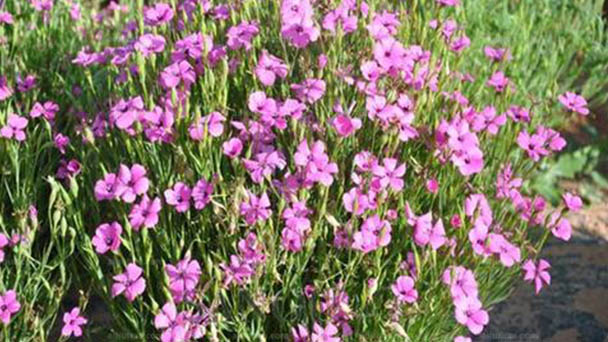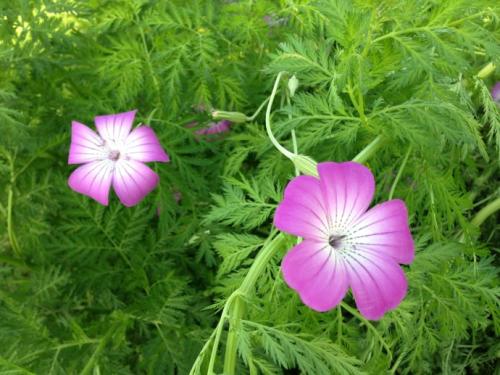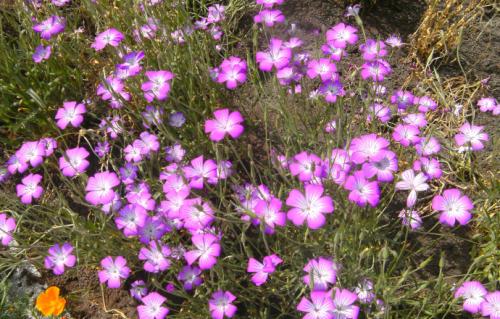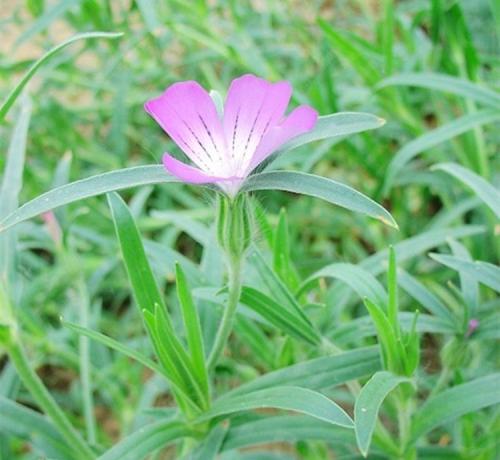Agrostemma githago (corncockle) profile
Written by Maggie
Mar 17 2021

Agrostemma Githago, common name corncockle, is an annual herb of the family Caryophylla, with a height of 60-90 cm. The whole plant is densely covered with white bristles.
Stem of Agrostemma githago solitary is erect, unbranched or distally branched. Leaf blade is linear or linear-lanceolate, base microconnate, branching stem, apex acuminate, midvein obvious.
The stamens of Agrostemma githago are slightly exerted, filaments glabrous; Style is exerted, hairy.
Capsule of Agrostemma githago is ovate, slightly longer than persistent calyx, exovolous; Seeds are irregularly ovate or round kidney - shaped, black, with spines.
Agrostemma Githago picture

Morphological characteristics of Agrostemma Githago
Agrostemma githago, leaves are linear or linear-lanceolate, 4 -- 11 cm long, 2 -- 10 mm wide, basally connate or slightly connate, apex acuminate, midvein convex abaxially.
Flowers of Agrostemma githago are large, ca. 3 cm in diameter, solitary at apex of stem and branch; Calyx is 5-lobed, calyx tube oblong-cylindric, 12-14 mm long, with 10 ascending veins, apically slightly narrow,
After flowers, calyx tube is thickened, calyx lobes linear, leaves inflexed, longer than calyx tube, up to 3 cm long, with 1 vein;
Agrostemma githago has 5 petals, much shorter than calyx lobes, red purple, obovate to cuneate, base tapering into claws, pawls white, tip emarginate;
Agrostemma githago has 10 stamens, two wheels, outer stamens base and petals connected;
Ovary is 1-loculed, styles 5, slender, erect, hirsute, subequal to stamens.
Capsule of Agrostemma githago is ovate, slightly longer than calyx tube, 5-dentate lobes, teeth outwards, and calyx lobes alternate;
Seeds of Agrostemma githago are slightly irregularly ovate or rounded reniform, black at maturity, 2.5-3 mm long, densely surfacing with more pointy verrucous protuberances.
Adult plant: Plant height 30 -- 80cm, the whole plant has white bristles, stalk erect, single or branching.
Leaves of Agrostemma githago are linear or linear-lanceolate, 3 -- 13cm long and 2 -- 10mm wide, basally connate, with semi-adnate white hairs on both surfaces, midvein convex on abaxial surface.
Flowers of Agrostemma githago are large, about 3cm in diameter, solitary at stem apex and branch tip; Calyx tube is oblong-cylindric, 1.5 -- 2cm long, externally pubescent, with 10 raised veins, postanthesis calyx tube thick, lobes 5, linear, up to 3cm long;
Fruit: Capsule is ovate, slightly longer than calyx tube, enveloped by persistent calyx tube, 1 locule, containing several seeds;
Seeds of Agrostemma githago are triangular-reniform, 2.5 -- 3.5mm long and 3.5mm wide, black or subblack, dull, surface with concentric rings arranged in irregular size spinous processes.
The hilum is located at the lower end, and its two sides are slightly concave inward to form a shallow notch. Embryos along the back, around the endosperm, were light yellow; The endosperm is rich and white.
Ecological habits of Agrostemma Githago
Agrostemma githago is a weed in wheat fields or grasslands along the road.
Agrostemma githago flowers in the summer and is highly adaptable, self-sowing and thriving.
The distribution area of Agrostemma Githago
Agrostemma Githago is produced in Heilongjiang, Jilin, Inner Mongolia and Xinjiang.
Agrostemma githago is also found in Europe, Asia, northern Africa and North America.

Plant hazards of Agrostemma Githago
Agrostemma githago is often born in wheat fields and is a weed introduced with wheat seeds in the early years. Specimens were collected in northeast China in the 19th century. The flowers are also introduced and cultivated because of their bright color.
Agrostemma githago often harms wheat, corn, soybean and other crops and turf in northern China.
Since the whole plant, especially the seeds, is poisonous and can cause damage to the physical health of humans, livestock and poultry when mixed with food,
Escape Agrostemma githago can be a direct threat to horses, pigs, calves and birds.
Agrostemma githago medicinal value
Agrostemma githago is used to treat whooping cough and other diseases. Stems, leaves and seeds are poisonous.
The toxicity of Agrostemma githago
Agrostemma githago is a poisonous plant included in the Chinese Plant Atlas Database. Its toxicity is seed toxicity, and its toxicity is related to soil and maturity.
The toxicity of exocarp was not significant, and the toxic substances mainly concentrated in kernels and embryos.
Continuous consumption of seeds by animals in small quantities can lead to chronic poisoning, commonly known as "Agrostemma Githago poisoning". The main symptoms include salivation, nausea, vomiting, diarrhea, dizziness, dyspnea, coma, paralysis and so on.
Continuous consumption in large quantities can cause more serious symptoms, such as intense muscle pain, cramps, respiratory depression and even death. Horse acute poisoning still pulses fast and weak, temperature rise, myotonia, convulsions and death.

Latest Updated
- Benefits of Bugleweed - 7 Science-backed Health Benefits
- Bugleweed Dangers & Side Effects - Is It Poisonous?
- How to Plant Evergreen Trees - What You Should Know
- When to Plant Evergreens - Grow Guide for Evergreen Trees
- 12 Wonderful Evergreen Shrubs for Your Garden
- 12 Popular Evergreen Plants with Pictures for Beginners
- When And How To Prune A Lilac Bush Like a Pro
- How to Grow & Care for Lilac Vine (Hardenbergia Violacea)
- Japanese Lilac Tree (Syringa Reticulata) Care & Propagation Guide
- Shumard Oak Pros and Cons - What to Know
Popular Articles
- Winter maintenance of Antirrhinum Majus
- How to Grow Terminalia Mantaly Tree
- How to Grow and Care for Crossostephium Chinense
- How to grow Antirrhinum Majus in spring
- Peristeria Elata (Dove Orchid) Profile: Info & Care Guide
- Underwatered Snake Plant (Sansevieria Trifasciata) - Signs And How To Fix
- How to Care for Brazilian Jasmine Plant (Mandevilla Sanderi)
- How to Grow & Care for Graptopetalum Purple Delight in Summer
- Rosa Chinensis (China Rose): Plant Growing & Care Tips
- How to Care for Baby Sun Rose (Aptenia Cordifolia)